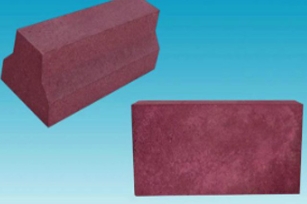- 22
- Sep
Cegła chromowo-korundowa
Cegła chromowo-korundowa

1. Chrome corundum bricks are also called high wear-resistant chromium corundum tapping channel bricks. It is a high-end product that our company has promoted to the market in the past few years. It is synthesized from pure alumina Al2O3 and chromium oxide Cr2O3 as the main raw materials. Compared with pure corundum bricks, it has better properties, such as refractoriness and softening deformation under load. Temperature, flexural strength, high temperature creep, high temperature volume stability and slag corrosion resistance.
2. Mainly used for rolling steel heating furnace slide rails and tapping platforms, troughs, and other easily worn parts of industrial furnaces. Chrome corundum brick is a kind of high-grade refractory material, and its service life can reach 10 to 18 months after many rolling mill users.
3. Practice shows that wear-resistant chromium corundum tapping channel bricks are used in the tapping channel of the rolling furnace for heating large-section billets, large friction per unit area and high output, which can not only significantly extend the service life of the tapping channel, and reduce stoppages. Furnace time, increase production, reduce refractory consumption and maintenance costs, and the reduction of the number of rapid cooling and heating due to shutdown of the furnace for maintenance, so that the overall life of the furnace is improved, and obvious economic benefits can be obtained. 4. Using α-Al2O3 as raw material, adding appropriate amount of chromium oxide powder and fine chromium corundum clinker powder, after forming, sintering at high temperature. The chromium oxide content of sintered chromium rigid bricks is generally lower than that of fused-cast chromium corundum bricks. It can also be prepared by the slurry casting method. The α-Al2O3 powder and the chromium oxide powder are uniformly mixed, and the glue and organic binder are added to make a thick slurry. At the same time, part of the chromium corundum clinker is added, and the brick is made by the grouting method. Fire again. It can be used as the lining of glass kiln, the cover brick of the drawing glass flow hole and the backing of hot metal pretreatment device, garbage incinerator, coal water slurry pressurized gasifier, etc.
5. Refractory products with alumina content greater than 90% and corundum as the main crystal phase. Very high normal temperature compressive strength (up to 340MPa). High load softening start temperature (more than 1700°C). Very good chemical stability, strong resistance to acidic or alkaline slag, metal and glass liquid. Thermal shock stability is related to its structure. The corrosion resistance of dense products is good, but thermal shock stability is poor. There are two types of sintered corundum bricks and fused corundum bricks. Sintered alumina and fused corundum can be used as raw materials, or bauxite clinker with high Al2O3/SiO2 ratio can be combined with sintered alumina and made by sintering method. Phosphoric acid or other bonding agents can also be used to make non-fired corundum bricks.
6. Mainly used in ironmaking blast furnaces and blast furnace hot blast furnaces, refining furnaces outside steelmaking furnaces, sliding water heaters, glass melting furnaces and petrochemical industrial furnaces. Corundum bricks are widely used in the lining of various high-temperature kilns and kiln furniture in the petrochemical and fertilizer industries, such as cracking, reforming furnaces, and metallurgical industries.
7. Physical and chemical indicators
| projekt | Cegła o wysokiej zawartości tlenku chromu | Medium chromium oxide | Cegła chromowo-korundowa | Cegła chromowo-korundowa | Cegła chromowo-korundowa |
| Cr2O3% | ≥93 | ≥86 | ≥60 | ≥30 | ≥12 |
| Al2O3% | – | – | ≤ 38 | ≤ 68 | ≤ 80 |
| Fe2O3% | – | – | ≤ 0.2 | ≤ 0.2 | ≤ 0.5 |
| Porowatość pozorna % | ≤ 17 | ≤ 17 | ≤ 14 | ≤ 16 | ≤ 18 |
| Gęstość nasypowa g / cm3 | ≥4.3 | ≥4.2 | ≥3.63 | ≥3.53 | ≥3.3 |
| Wytrzymałość na ściskanie w temperaturze pokojowej MPa | ≥100 | ≥100 | ≥130 | ≥130 | ≥120 |
| Load softening start temperature ℃ | ≥1680 | ≥1670 | ≥1700 | ≥1700 | ≥1700 |
| (0.2MPa, 0.6%) | |||||
| Zmiana tempa ponownego wypalania linii% | ± 0.2 | ± 0.2 | ± 0.2 | ± 0.2 | ± 0.2 |
